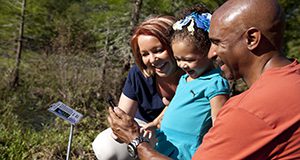Abstract
Although millions of people recreate in parks, forests, and other conservation areas in the United States every year, research shows that some are left out; not everyone takes advantage of natural areas for the numerous benefits nature-based recreation provides. Results show that many people who do not participate in nature-based recreation feel constrained by their quality of time, not the quantity of time. In other words, they're saying, "Prove to me that it's worth my time to go out in nature. Show me something cool!" Based on research conducted in Hillsborough County, Florida and similar studies, this 6-page fact sheet written by Margaret E. Gullion and Taylor Stein and published by the UF/IFAS School of Forest Resources and Conservation addresses identifies strategies to improve the opportunities natural areas can provide a diverse public.
https://edis.ifas.ufl.edu/fr415
References
Breitenstein, D., and A. Ewert. 1990. "Health benefits of outdoor recreation: Implications for health education" Health Education 21 (1): 16-21. https://doi.org/10.1080/00970050.1990.10616165
Green, G. T., J. M. Bowker, X. Wang, H. K. Cordell, and C. Y. Johnson. 2012. A national study of constraints to participation in outdoor recreational activities. In H. K. Cordell (Ed.), Outdoor recreation trends and futures (pp. 70-74). Asheville, NC: U.S. Department of Agriculture Forest Service, Southern Research Station.
Hartig, T., R. Mitchell, S. de Vries, and H. Frumkin. 2014. "Nature and health." Annual Review of Public Health 35 207-228. https://doi.org/10.1146/annurev-publhealth-032013-182443
Jackson, E. L. 2001. "Will research on leisure constraints still be relevant in the Twenty-first Century?" Journal of Leisure Research 32 (1): 62-68.
https://doi.org/10.1080/00222216.2000.11949887
Krymkowski, D. H., R. E. Manning, and W. A. Valliere. 2014. "Race, ethnicity, and visitation to national parks in the United States: Tests of the marginality, discrimination, and subculture hypotheses with national-level survey data." Journal of Outdoor Recreation and Tourism,7-8: 35-43. https://doi.org/10.1016/j.jort.2014.09.008
Larson, L. R., G. T. Green, and H. K. Cordell. 2011. "Children's time outdoors: Results and implications of the National Kids Survey." Journal of Park and Recreation Administration 29 (2): 1-20.
Metcalf, E. C. R. Burns, and A. Graefe. 2013. "Understanding non-traditional forest recreation: The role of constraints and negotiation strategies among racial and ethnic minorities." Journal of Outdoor Recreation and Tourism, 1-2: 29-39. https://doi.org/10.1016/j.jort.2013.04.003
The Outdoor Foundation. 2017. Outdoor Participation Report 2017. The Outdoor Foundation, Washington, D.C. 43pp.
Shores, K. A., D. Scott, and M. F. Floyd. 2007. "Constraints to outdoor recreation: A multiple hierarchy stratification perspective." Leisure Sciences 29: 227-246. https://doi.org/10.1080/01490400701257948.
Scott, D., and E. L. Jackson. 1996. "Factors that limit and strategies that might encourage people's use of public parks." Journal of Park and Recreation Administration 14 (1): 1-17.
Whiting, J. W., L. R. Larson, G. T. Green, and C. Kralowec. 2017. "Outdoor recreation motivation and site preferences across diverse racial/ethnic groups: A case study of Georgia state parks." Journal of Outdoor Recreation and Tourism 18 10-21 https://doi.org/10.1016/j.jort.2017.02.001
Unless otherwise specified, articles published in the EDIS journal after January 1, 2024 are licensed under a Creative Commons Attribution-NonCommercial-NoDerivs 4.0 International (CC BY-NC-ND 4.0) license.

